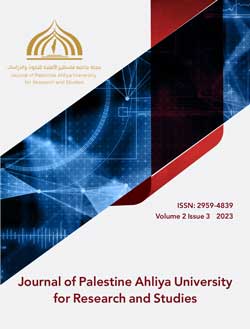Assessing the Level of Job Engagement among Employees in Major Municipalities in the Gaza Strip
DOI:
https://doi.org/10.59994/pau.2023.3.67Keywords:
Job Engagement, Major Municipalities, Gaza StripAbstract
The aim of this study was to explore the reality of Job engagement and its components (job involvement, job satisfaction, and job enthusiasm) from the perspective of employees in the major municipalities in the Gaza Strip. The descriptive-analytical approach was used, with a study population of 2,714 employees. The sample consisted of 336 employees selected through stratified random sampling. A questionnaire was used as a data collection tool, and 227 questionnaires were retrieved, representing 75.89% of the study sample. Data analysis was conducted using SPSS software to obtain the results. The study revealed several findings, the most prominent of which was the presence of Job engegement in the major municipalities in the Gaza Strip at a high level, with a rate of 71.7%. The study recommended that municipal management involve employees in decision-making processes and encourage them to contribute ideas and suggestions that contribute to work development through various competitions. It also recommended that municipal management pay more attention to the work environment, create a well-prepared environment, provide financial incentives in addition to motivational incentives, and provide opportunities for employees to attend training courses to enhance job satisfaction. Furthermore, the study emphasized the importance of addressing the psychological aspects of employees by designing stimulating programs aimed at increasing enthusiasm and dedication to work, as well as promoting cooperative work through organizing informative and educational seminars to ensure the continuous provision of services to the community.
Downloads
References
أولاً: المراجع العربية
حدّاد، نرمين. (2016). دور إدماج الموظفين في رفع مستوى أداءهم في المصارف السورية الخاصة. (رسالة ماجستير غير منشورة). الجامعة الافتراضية السورية، سورية.
حميد، حازم. (2018). إدارة المواهب وأداء المنظمة- الدور الوسيط للاندماج الوظيفي: دراسة حالة بنك فلسطين في قطاع غزة. (رسالة ماجستير غير منشورة). الجامعة الإسلامية، غزة.
الخالدي، صالح. (2020). التغير التنظيمي بالإعتماد على استراتيجية اندماج الموارد البشرية دراسة ميدانية في قطاع الاتصالات في سلطنة عمان. في المجلة العربية للنشر العلمي. (25). المجلة العربية للنشر العلمي.
دهليز، خالد؛ حمد، محمد. (2016). أثر الارتباط الوظيفي والدعم التنظيمي المدرك على الأداء الوظيفي في المؤسسات الأكاديمية الفلسطينية. مجلة الجامعة الإسلامية للدراسات الاقتصادية والإدارية، 24(4)، 26–50.
الطهراوي، عبد المنعم. (2021). دور الهيئات المحلية في التنمية وإعادة الحياة في محافظات قطاع غزة. شبكة المنظمات الأهلية الفلسطينية، 1–16.
عايش، هيثم، و قديح، لؤي. (2020). دور الموازنات في التخطيط بالبلديات الفسطينية: دراسة تطبيقية على البلديات الخمس الكبرى في قطاع غزة. مجلة الاقتصاد والمالية، 6(1)، 36–47.
عبد القادر، سعدة؛ بخوش، مديحة. (2020). حوكمة الموارد البشرية كمدخل لتعزيز مقومات الاندماج الوظيفي: دراسة حالة مؤسسة اتصالات الجزائر-فرع ولاية الأغواط. مجلة دراسات العدد الاقتصادي، 11(1)، 95–119.
العتيبي، سعد. (2018). التمكين النفسي وعلاقته بكل من الالتزام التنظيمي والاندماج في العمل لدى العاملين في شركة التأمين الخاصة بمدينة الرياض. المجلة العربية للإدارة، 38(4)، 115–143.
عسلي، نور الدين. (2018). دراسة أثر الاندماج الوظيفي على أداء العاملين في المستشفيات العمومية دراسة ميدانية لعينة في مستشفى الزهراوي في ولاية المسلية. مجلة العلوم الاقتصادية والتسيير والعلوم التجارية، 11(1)، 142–153.
عليوة، أمينة. (2021). أثر الرضا الوظيفي على اندماج الموظفين بالمستشفيات الحكومية في قطاع غزة. (رسالة ماجستير غير منشورة). الجامعة الإسلامية، غزة.
الفليت، خلود؛ عابدين، عبد الرحمن. (2021). ترتيبات العمل المرن وأثر على الارتباط الوظيفي: دراسة تطبيقية على العاملين بشركات الانترنت في قطاع غزة. مجلة المثنى للعلوم الإدارية والاقتصادية، 11(3)، 90–106.
مرزوق، سارة؛ بوعشة، مبارك. (2017). دراسة أثر التمكين في تحقيق الاندماج الوظيفي للعاملين: دراسة حالة مجمع عموري بسكرة. مجلة دراسات اقتصادية، 4(3(، 162-187.
ملحم، مروان؛ مودة، حبسة؛ أحمد، خليل. (2019). تأثير أسلوب القيادة التحويلية على اندماج الموظفين - استخدام نمذجة المعادلات الهيكلية. المجلة الدولية للاتجاهات الحديثة في العلوم الاجتماعية. 2(8)، 162-173.
النعامي، علي؛ الباز، عماد؛ و الخيسي؛ عبد الباسط. (2014). مدى مساهمة وظيفة التدقيق الداخلي في ضبط الأداء المالي و الإداري في هيئات الحكم المحلي بقطاع غزة: دراسة تطبيقية تحليلية. مجلة جامعة القدس المفتوحة للأبحاث و الدراسات الإدارية و الاقتصادية، 1(1)، 191–234.
الهيتي، صلاح؛ محمود، درداء. (2021). تأثير اندماج العاملين في ريادة الأعمال: دراسة تطبيقية لعينة من الشركات العائلية في بغداد. مجلة الدنانير، 1(21)، 538–569.
الوقائع الفلسطينية. (2009). قرار مجلس الوزراء الفلسطيني رقم (1) لسنة 2009 بشأن نظام موظفي الهيئات المحلية. جامعة بيرزيت.
الوقائع الفلسطينية. (2020). تعليمات رقم (1) لسنة 2020م بشأن موظفي الهيئات المحلية. 1، 2–30.
وزارة الحكم المحلي. (2005). دراسة استطلاعية حول تصنيف الهيئات المحلية الفلسطينية. الإدارة العامة للتطوير والبحث والدراسات. 1–74.
وزارة الحكم المحلي. (2010). الإطار الاستراتيجي لوزارة الحكم المحلي (2010-2014). رام الله، وزارة الحكم المحلي.
وزارة الحكم المحلي. (2020(. تقرير الأداء السنوي لوزارة الحكم المحلي لعام (2020). رام الله، وزارة الحكم المحلي.
المراجع العربية بنظام الرومنة:
hdad, nrmyn. (2016). dwr edmaj almwzfyn fy rf'e mstwa ada'hm fy almsarf alswryh alkhash. (rsalh majstyr ghyr mnshwrh). aljam'eh alaftradyh alswryh, swryh.
hmyd, hazm. (2018). edarh almwahb wada' almnzmh- aldwr alwsyt llandmaj alwzyfy: drash halh bnk flstyn fy qta'e ghzh. (rsalh majstyr ghyr mnshwrh). aljam'eh aleslamyh, ghzh.
alkhaldy, salh. (2020). altghyr altnzymy bale'etmad 'ela astratyjyh andmaj almward albshryh drash mydanyh fy qta'e alatsalat fy sltnh 'eman. fy almjlh al'erbyh llnshr al'elmy. (25). almjlh al'erbyh llnshr al'elmy.
dhlyz, khald؛ hmd, mhmd. (2016). athr alartbat alwzyfy wald'em altnzymy almdrk 'ela alada' alwzyfy fy alm'essat alakadymyh alflstynyh. mjlh aljam'eh aleslamyh lldrasat alaqtsadyh waledaryh, 24(4), 26–50.
althrawy, 'ebd almn'em. (2021). dwr alhy'eat almhlyh fy altnmyh we'eadh alhyah fy mhafzat qta'e ghzh. shbkh almnzmat alahlyh alflstynyh, 1–16.
al'etyby, s'ed. (2018). altmkyn alnfsy w'elaqth bkl mn alaltzam altnzymy walandmaj fy al'eml lda al'eamlyn fy shrkh altamyn alkhash bmdynh alryad. almjlh al'erbyh lledarh, 38(4), 115–143.
'eaysh, hythm, w qdyh, l'ey. (2020). dwr almwaznat fy altkhtyt balbldyat alfstynyh: drash ttbyqyh 'ela albldyat alkhms alkbra fy qta'e ghzh. mjlh alaqtsad walmalyh, 6(1), 36–47.
'ebd alqadr, s'edh؛ bkhwsh, mdyhh. (2020). hwkmh almward albshryh kmdkhl lt'ezyz mqwmat alandmaj alwzyfy: drash halh m'essh atsalat aljza'er-fr'e wlayh alaghwat. mjlh drasat al'edd alaqtsady, 11(1), 95–119.
'esly, nwr aldyn. (2018). drash athr alandmaj alwzyfy 'ela ada' al'eamlyn fy almstshfyat al'emwmyh drash mydanyh l'eynh fy mstshfa alzhrawy fy wlayh almslyh. mjlh al'elwm alaqtsadyh waltsyyr wal'elwm altjaryh, 11(1), 142–153.
'elywh, amynh. (2021). athr alrda alwzyfy 'ela andmaj almwzfyn balmstshfyat alhkwmyh fy qta'e ghzh. (rsalh majstyr ghyr mnshwrh). aljam'eh aleslamyh, ghzh.
alflyt, khlwd؛ 'eabdyn, 'ebd alrhmn. (2021). trtybat al'eml almrn wathr 'ela alartbat alwzyfy: drash ttbyqyh 'ela al'eamlyn bshrkat alantrnt fy qta'e ghzh. mjlh almthna ll'elwm aledaryh walaqtsadyh, 11(3), 90–106.
mrzwq, sarh؛ bw'eshh, mbark. (2017). drash athr altmkyn fy thqyq alandmaj alwzyfy ll'eamlyn: drash halh mjm'e 'emwry bskrh. mjlh drasat aqtsadyh, 4(3(, 162-187.
mlhm, mrwan؛ mwdh, hbsh؛ ahmd, khlyl. (2019). tathyr aslwb alqyadh althwylyh 'ela andmaj almwzfyn - astkhdam nmdjh alm'eadlat alhyklyh. almjlh aldwlyh llatjahat alhdythh fy al'elwm alajtma'eyh. 2(8), 162-173.
aln'eamy, 'ely؛ albaz, 'emad؛ w alkhysy؛ 'ebd albast. (2014). mda msahmh wzyfh altdqyq aldakhly fy dbt alada' almaly w aledary fy hy'eat alhkm almhly bqta'e ghzh: drash ttbyqyh thlylyh. mjlh jam'eh alqds almftwhh llabhath w aldrasat aledaryh w alaqtsadyh, 1(1), 191–234.
alhyty, slah؛ mhmwd, drda'. (2021). tathyr andmaj al'eamlyn fy ryadh ala'emal: drash ttbyqyh l'eynh mn alshrkat al'ea'elyh fy bghdad. mjlh aldnanyr, 1(21), 538–569.
alwqa'e'e alflstynyh. (2009). qrar mjls alwzra' alflstyny rqm (1) lsnh 2009 bshan nzam mwzfy alhy'eat almhlyh. jam'eh byrzyt.
alwqa'e'e alflstynyh. (2020). t'elymat rqm (1) lsnh 2020m bshan mwzfy alhy'eat almhlyh. 1, 2–30.
wzarh alhkm almhly. (2005). drash asttla'eyh hwl tsnyf alhy'eat almhlyh alflstynyh. aledarh al'eamh llttwyr walbhth waldrasat. 1–74.
wzarh alhkm almhly. (2010). aletar alastratyjy lwzarh alhkm almhly (2010-2014). ram allh, wzarh alhkm almhly.
wzarh alhkm almhly. (2020(. tqryr alada' alsnwy lwzarh alhkm almhly l'eam (2020). ram allh, wzarh alhkm almhly.
ثانياً: المراجع الأجنبية
Chauhan, A. S. (2018). Job satisfaction as a tool to engage Employees at workplace. International Journal of Creative Research Thoughts (IJCRT), 6(1), 1467-1469
Federman, B. (2009). Employee Engagement-A Roadmap for Creating Profi ts, Optimizing Performance، and Increasing Loyalty (1st ed). USA, John Wiley & Sons, Inc.
Gallup. (2020a). Boost your employee engagement today-Effectory’s study of the Global Employee Engagement Index 2020. https://www.gallup.com/
Gallup. (2020b). Gallup co. Retrieved from: https://www.gallup.com/home.aspx
Hewitt, A. (2015). Trends in Global Employee Engagement. Aon Empower Results, 13(3).
Hrgovic, A. M. F., Arngar, C., & Shkarika, I. (2020). Employee engagement and improvement as important principles of TQM in public health institutes. Proceedings of the Polytechnic of Rijeka, 8(1), 189–201.
Lee, S., & Seo, H. (2021). The Relationship Between the Emotional Labor, Job Enthusiasm and Job Burnout of Pilates Instructors. Asia-Pacific Journal of Convergent Research Interchange, 7(6), 25–36.
Macey, W. H., & Schneider, B. (2008). The meaning of employee engagement. Industrial and organizational Psychology, 1(1), 3-30.
Nasima, A., & Shalini, P. (2018). Determinants of Engaging Employees at Work Place. Eurasian J. Anal. Chem., 13(6), 143-151.
Osborne, S., & Hammoud, M. S. (2017). Effective Employee Engagement in the Workplace. International Journal of Applied Management and Technology, 16(1)، 50–67. https://doi.org/10.5590/ijamt.2017.16.1.04
Peters, J. (2019). EMPLOYEE ENGAGEMENT-Creating positive energy at work (1st ed). USA, KR Publishing.
Schaufeli, W. B., & Bakker, A. B. (2002). Job demands, job resources and their relationship with burnout and engagement: A multi-sample study on the COBE-model. Utrecht University, Netherlands.
Turner, P. (2020). Employee Engagement in Contemporary Organizations-Maintaining High Productivity and Sustained Competitiveness. Employee Engagement in Contemporary Organizations (eBook). Springer Nature Switzerland AG. https://doi.org/10.1007/978-3-030-36387-1
Robbins, S., & Judge, T. A. (2018). Essentials of Organizational Behavior (14th ed.). U.K, Pearson Education Limited.
Vance, R. J. (2006). Employee Engagement and Commitment. SHRM Foundation, 1, 1-53.

Downloads
Published
How to Cite
Issue
Section
License
Copyright (c) 2023 Journal of Palestine Ahliya University for Research and Studies

This work is licensed under a Creative Commons Attribution 4.0 International License.
مجلة جامعة فلسطين الاهلية للبحوث والدراسات تعتمد رخصة نَسب المُصنَّف 4.0 دولي (CC BY 4.0)











